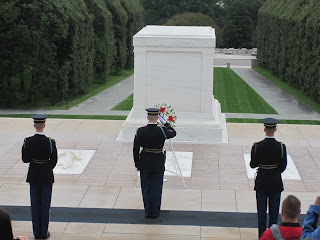We arrived in Gettysburg in the later afternoon of the 1st of October and set up camp right beside the Gettysburg National Military Park. The RV Park was part of the National Horse Academy with several large barns and corrals throughout the park area.
On Monday, we took a bus tour into Washington, DC. We spent many hours touring, wandering and visiting several sites in the City. One of the first stops for us was Arlington National Cemetery.
Arlington is a military cemetery, established during the American Civil War on the grounds of Arlington House, formerly the estate of the family of Confederate general Robert E. Lee. This was the family home.
The cemetery is situated directly across the Potomac River from the Lincoln Memorial in Washington, DC. About 1500 military veterans are dying daily in the USA and Arlington is having as many at 10 funerals a day. It covers an area of 624 acres and veterans and military casualties from each of the nation's wars are interred in the cemetery, ranging from the American Civil War through to the military actions in Afghanistan and Iraq. Pre-Civil War dead were reinterred after 1900. Among the most frequently visited sites in the cemetery is the grave of President John F. Kennedy, who is buried with his wife, Jacqueline, and two of their children. The grave is marked with the "eternal flame". The remains of his brothers, Senator Robert F. Kennedy and Senator Edward M. "Ted" Kennedy, are buried nearby.
We also visited the Tomb of the Unknown Soldier and observed the changing of the guard and the Arlington Memorial Amphitheater.
We walked around several memorials there including a memorial to the 266 men who lost their lives aboard the USS Maine (The memorial is built around a mast salvaged from the Maine’s wreckage) and the Space Shuttle Challenger Memorial (the memorial dedicated to the Shuttle Columbia which broke apart during reentry on February 1, 2003). We also saw The Cairn, a memorial to the 270 killed in the bombing of Pan Am Flight 103 over Lockerbie, Scotland as well as The Women in Military Service for America Memorial.
We drove around Washington and stopped to see the Iwo Jima memorial;
the Vietnam memorial;
and the World War II memorial.
Then the Washington monument and Lincoln memorial;
The Capital;
The Jefferson memorial;
We then headed to the Smithsonian. Founded in 1846, the Smithsonian is the world's largest museum and research complex, consisting of 19 museums and galleries in eight buildings, the National Zoological Park and nine research facilities. We only had a couple of hours to pick one of the museums and have a brief look around so we picked the American History Museum which is devoted to the scientific, cultural, social, technological, and political development of the United States. We had a chance to view the original Star-Spangled Banner, the flag that inspired the national anthem; Washington’s uniform; Jefferson’s lap desk; Dorothy’s ruby slippers; Archie Bunker’s chair, Jim Henson's first puppets, a collection of early musical instruments, Julia Childs’ kitchen and a host of other very interesting exhibits which documented the growth of America and its people. Susan was quite intrigued by the displays of the First Ladies of America’s ball gowns used at their husband’s inauguration as President.
The next day we drove around the city of Gettysburg and then out on the battlefield and saw a few of the over 850 monuments and markers at Gettysburg along with some of the farms which were either headquarters or field hospitals. These monuments erected by the various States and Armed Forces are all a credit to the 150,000 men who fought that battle. The Battle of Gettysburg was a turning point in the Civil War, the Union victory that ended General Robert E. Lee's second and most ambitious invasion of the North in 1863. Often referred to as the "High Water Mark of the Rebellion", it was the war's bloodiest battle with 51,000 casualties and the setting for President Abraham Lincoln's "Gettysburg Address".
We also took a walking tour of the downtown area. Most of the buildings there were all pre Civil War, most being constructed in the early 1800's.
On Wednesday we took a trip on horseback along the edges of the battlefield where no vehicles could travel and had a very interesting time with the guide who knew a lot of the details of the battle and pointed out a lot of interesting facts to us.
Later that evening we climbed up on
We are shortly to be on our way, through Pennsylvania, then on to Maryland and finally into Virginia where we will be heading through the Shenandoah Valley, bordered by the Allegheny Mountains and the Blue Ridge Mountains to the city of Lexington. After spending four days there we will be heading to the city of Elizabethtown in Kentucky.
Little Round Top, site of one of the Battle's most famous chapters and a stunningly beautiful prominence providing a panoramic view of almost the entire battlefield.
















































No comments:
Post a Comment